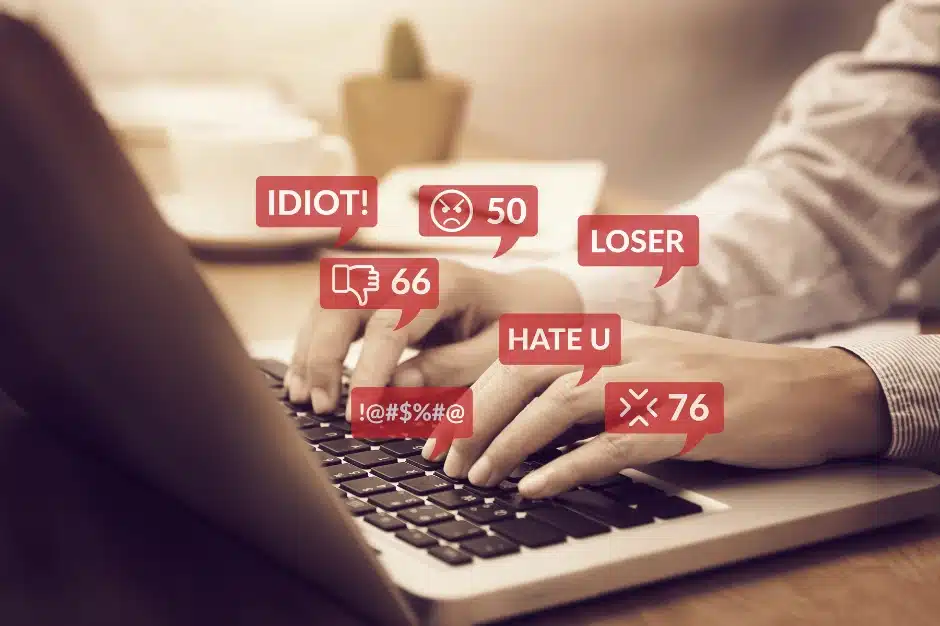 Social media sites have allowed us to connect with people from around the world. To share our fondest memories and to keep in touch with family and long-time friends. However, with its many benefits come several downfalls. Social media also gives bullies better access to their victims and allows them to hide behind anonymity.
Social media sites have allowed us to connect with people from around the world. To share our fondest memories and to keep in touch with family and long-time friends. However, with its many benefits come several downfalls. Social media also gives bullies better access to their victims and allows them to hide behind anonymity.
Social media sites are many. However, there are some sites where cyberbullying tends to be more common. In this article, we’ll discuss the top social media sites for cyberbullying, the impacts of social media cyberbullying, and what can be done to solve the problem.
In This Article:
- Why Social Media Can Be Harmful
- Popular Social Media Sites
- Top 5 Social Media Sites for Cyberbullying
- Impacts of Social Media Cyberbullying
- Solving the Social Media Cyberbullying Problem
Why Social Media Can Be Harmful
Cyberbullying can occur across all ages but tends to be the most common and most harmful among teens and young adults. Adolescents are at the peak of their cognitive development so making good decisions using social media can be challenging, opening the door for cyberbullying.
Cyberbullying can take on many forms including harassment, discrimination, spreading rumors, sharing private information, cyberstalking, and social exclusion. These behaviors can be especially damaging for teens and young adults who are still discovering themselves and learning how to stand up for themselves.
The adults in a teen’s life have the responsibility to look out for harmful behaviors that occur on social media platforms. Risks to be aware of include:
- Some content is hurtful or incorrect.
- Apps can easily be used to share adult content.
- Social media sites can include users of all ages making it easy for adults to connect to children.
- Apps rarely have a moderator for groups, chats, and forms, allowing any type of harmful content to be posted.
- Not all apps make it easy for the user to adjust privacy controls over who can access or view their material.
- Apps like Facebook Live and Instagram Live allow users to stream real-time videos to a wide audience and can be used to show violence, bullying, suicide, and other harmful acts.
- A user’s location can be used to obtain personal information.
- Some apps support phone calls but do not show up in a phone long making it difficult for parents to know who their teen is talking to.
Popular Social Media Sites
There are almost too many social media sites and applications to count. But here are some of the most popular social media sites used by teens and young adults. It’s important for parents to know what is out there so they are better equipped to look out for any potentially harmful sites.
Amino: An app that lets users join online communities, chats, forums, and groups on a variety of topics based on their interests.
BeReal: An app where users can post a photo once a day documenting their environment. These images can only be seen by the user’s friends.
Discord: A voice-over-IP (VOIP) app that allows users to communicate using video messages, voice calls, texts, and media. This app is commonly used among video gamers.
Facebook: The most commonly used social media site that is accessible on many different media platforms.
Instagram: A photo and video sharing and networking site that connects users through other social networking sites (e.g., Facebook).
Reddit: A site that stores social news, rates and evaluates web content, and discussion threads Snapchat: A photo messaging app that allows for sharing pictures and short videos that are intended to be erased shortly after delivery.
Telegram: Messaging app that allows users to share photos, videos, and files; make calls, and delete texts or chats from recipient’s phone using a timer.
TikTok: An app that allows users to create and share their own videos where they lip-synch, sing, dance, or just talk. Twitch: A live stream platform for gamers to watch live stream content, chat, and connect
Twitter: A microblogging site that allows users to send, read, and reply to “tweets” or short messages.
WeChat: An app that allows users to chat with friends, and to search for people nearby and around the globe.
WhatsApp: A private messaging app that allows users to text, and send photos, videos, and location information to their contacts.
YouTube: A platform that allows users to share videos and receive comments, subscriptions, and follows from other users.
YUBO: An app referred to as the “Tinder for teens” that allows users to swipe right or left to accept or reject the profiles of other users.
Top 5 Social Media Sites for Cyberbullying
According to the Pew Research Center, 46% of teens report experiencing some form of online harassment or bullying. The most common type of bullying behavior tends to be name-calling. Among social media companies, the platforms with the highest prevalence of cyberbullying include:
- Facebook (75%): Despite a decline in popularity among teens, Facebook remains a hotspot for cyberbullying. Harsh comments on users’ self-photos, commonly known as selfies, are a common form of bullying on this platform. It’s a troubling cycle, as many teens posting photos seek positive affirmation but often end up receiving the opposite.
- Instagram (24%): Instagram, known for its visual content, has seen a surge in cyberbullying incidents. The rise of “rate me” posts or impromptu beauty contests is a concerning byproduct. It’s also easy to create a fake account on this platform, allowing bullies to hide behind anonymity
- Twitter (24%): This site allows users to quickly spread information to a wide audience. Misinformation and rumors can easily be spread using Twitter.
- Snapchat (15%): Snapchat is another social media site with a substantial cyberbullying presence. The ephemeral nature of Snapchat’s messages and Stories can encourage users to send hurtful content that disappears after being viewed. This fleeting nature can make it challenging to trace and report instances of bullying.
- TikTok (9%): TikTok’s duet feature creates a unique opportunity for cyberbullies. “Hate duets” are when a person responds to another’s video by pairing it with a violent or harassing video side-by-side.
It’s crucial for both parents and teens to be aware of these statistics and the potential risks associated with various social media platforms. Encouraging open communication, responsible online behavior, and the use of privacy settings can help mitigate the impact of cyberbullying in these digital spaces.
Impacts of Social Media Cyberbullying
The impacts of social media cyberbullying are profound and far-reaching, taking a toll on the emotional well-being and overall health of the victims. Statistics show that over half of teenagers who have experienced cyberbullying reported feeling anger, while about one-third felt deeply hurt, and nearly 15% experienced fear. These emotions are a testament to the distressing nature of online harassment and the negative psychological effects it can have on young individuals.
Among younger victims, specifically tweens (10-13), the consequences of cyberbullying are even more concerning. A staggering two-thirds of tween victims admitted that cyberbullying had a detrimental impact on their self-esteem and how they perceived themselves. This damaging blow to their self-image can have long-lasting implications, affecting their self-confidence and emotional stability as they grow into adolescence and adulthood.
Additionally, cyberbullying extends its reach beyond the virtual realm, with many victims reporting that these incidents strained their friendships. This social isolation and strained relationships can lead to feelings of loneliness and further exacerbate the emotional distress caused by cyberbullying. Shockingly, Cyberbullying spilled over into their physical health, highlighting the interconnectedness between mental and physical well-being in the face of online harassment.
Solving the Social Media Cyberbullying Problem
Many teens feel that cyberbullying is a major problem and do not feel that the people in charge do enough to address the problem. While anti-bullying organizations aim to educate and empower young people and their parents to prevent cyberbullying, sometimes there is no other choice than to take action.
In fact, the Pew Research Center also found that most teens believe that criminal charges would help in reducing the amount of social media cyberbullying. While this may be the extreme option, it may be the best way to hold bullies and other negligent parties accountable. When your child’s school or school district has not taken the proper steps to stop the social media cyberbullying your child faces, it may be time to contact an attorney who knows bullying laws in Chicago. Illinois has several cyberbullying laws meant to protect the victims and hold schools accountable for addressing any bullying that involves their students.
As a father, Attorney Larry Disparti is joining the fight to put an end to cyberbullying once and for all. Enough is enough. Our attorneys can help aid parents in writing letters to the school districts. When you find out your child is being cyberbullied, it’s normal to have a lot of emotions. Having a lawyer in your corner who knows what to look for in your case can go a long way and help you focus on your child’s needs. Do not hesitate to call us at (312) 600-6000 for a FREE case review.
Exploring Legal Options For Victims Of Cyberbullying
Cyberbullying, a form of harassment that occurs through digital platforms, can have severe emotional and psychological effects on victims. As online harassment becomes increasingly prevalent, understanding your legal options is crucial for seeking justice and protection. If you are a victim of cyberbullying, an Illinois cyberbullying lawyer explains several legal avenues available to address the issue and hold perpetrators accountable.
1. What Legal Actions Can I Take If I Am A Victim Of Cyberbullying?
Victims of cyberbullying have several legal options depending on the severity and nature of the harassment. Some potential actions include:
- Filing a Police Report: If the cyberbullying involves threats, stalking, or other criminal behavior, you can file a police report. Law enforcement can investigate the situation and potentially bring criminal charges against the perpetrator.
- Pursuing a Restraining Order: In cases of severe cyberbullying or threats of violence, you may seek a restraining order or protective order. This legal document can prohibit the perpetrator from contacting or approaching you, providing a layer of protection.
- Civil Lawsuits: You may also pursue a civil lawsuit against the perpetrator for damages caused by the cyberbullying. This can include claims for emotional distress, defamation, or other harm resulting from the harassment.
2. What Should I Do Before Taking Legal Action For Cyberbullying?
Before initiating legal action, it’s important to take several preparatory steps:
- Document the Harassment: Keep detailed records of all instances of cyberbullying, including screenshots, emails, text messages, and any other evidence. This documentation will be crucial in supporting your case and demonstrating the extent of the harassment.
- Report the Behavior: Report the cyberbullying to the platform or website where it occurred. Most social media sites and online services have policies against harassment and can take action, such as removing the offending content or suspending the perpetrator’s account.
- Seek Support: Consider consulting with a mental health professional to address the emotional impact of cyberbullying. Additionally, speaking with an attorney who specializes in cyber law or harassment can provide guidance on the best legal strategies for your situation.
3. Are There Specific Laws Or Statutes That Address Cyberbullying?
Cyberbullying is addressed through a combination of state and federal laws, though specific statutes can vary by jurisdiction:
- State Laws: Many states have enacted specific laws targeting cyberbullying, harassment, and online threats. These laws often define cyberbullying and set penalties for those who engage in such behavior. Your attorney can help you understand the laws in your state and how they apply to your case.
- Federal Laws: At the federal level, cyberbullying may fall under broader statutes related to harassment, stalking, or communications. For example, the Communications Decency Act provides some protection for online platforms but does not shield individuals from legal action.
- Educational Institution Policies: If cyberbullying involves a school setting, educational institutions may have their own policies and procedures for addressing harassment. Schools must often investigate and take action to prevent and address cyberbullying.
4. How Can An Attorney Help With A Cyberbullying Case?
An Illinois cyberbullying lawyer specializing in cyberbullying or harassment can provide invaluable assistance in several ways:
- Legal Advice: They can offer expert advice on your legal options, helping you understand the best course of action based on the specifics of your case and the applicable laws.
- Evidence Collection: An attorney can assist in gathering and organizing evidence, ensuring that your documentation is comprehensive and effectively supports your claims.
- Filing Claims and Representing You: They can handle the process of filing legal claims, whether for criminal charges, restraining orders, or civil lawsuits. They will represent you in court or negotiations, advocating on your behalf to achieve a favorable outcome.
- Negotiating Settlements: In some cases, resolving the issue through a settlement rather than a lengthy court process may be possible. An attorney can negotiate on your behalf to reach a fair settlement that addresses your needs and concerns.
Call Our Office For Legal Assistance
If you are a victim of cyberbullying, exploring your legal options and seeking professional assistance can help you address the issue effectively and protect your rights. By understanding the available legal remedies and working with an experienced Illinois cyberbullying lawyer, you can take appropriate steps to seek justice and find a resolution. Call Disparti Law Group to find out what legal recourse you may have.









